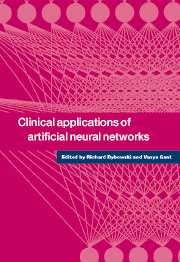Book contents
- Frontmatter
- Contents
- List of contributors
- 1 Introduction
- Part I Applications
- 2 Artificial neural networks in laboratory medicine
- 3 Using artificial neural networks to screen cervical smears: how new technology enhances health care
- 4 Neural network analysis of sleep disorders
- 5 Artificial neural networks for neonatal intensive care
- 6 Artificial neural networks in urology: applications, feature extraction and user implementations
- 7 Artificial neural networks as a tool for whole organism fingerprinting in bacterial taxonomy
- Part II Prospects
- Part III Theory
- Part IV Ethics and clinical prospects
- Index
6 - Artificial neural networks in urology: applications, feature extraction and user implementations
Published online by Cambridge University Press: 06 October 2009
- Frontmatter
- Contents
- List of contributors
- 1 Introduction
- Part I Applications
- 2 Artificial neural networks in laboratory medicine
- 3 Using artificial neural networks to screen cervical smears: how new technology enhances health care
- 4 Neural network analysis of sleep disorders
- 5 Artificial neural networks for neonatal intensive care
- 6 Artificial neural networks in urology: applications, feature extraction and user implementations
- 7 Artificial neural networks as a tool for whole organism fingerprinting in bacterial taxonomy
- Part II Prospects
- Part III Theory
- Part IV Ethics and clinical prospects
- Index
Summary
Introduction
Urology is a diverse surgical specialty that includes disorders of the urinary and male reproductive systems. As such, it includes diagnosis and treatment of cancers, urinary stones, male infertility, impotence, urinary diseases in children, neurological and anatomical disorders resulting in an inability to properly empty the bladder, trauma to the urinary and male reproductive systems, and other diseases. This diversity contributes to the challenging nature of diagnosing and treating urological disorders, and to the difficulty in modelling urological data sets.
In this chapter, we review urological diagnostic and prognostic modelling problems that we found intractable to discriminant function analysis in which neural computational modelling was superior in performance. Because of its simplicity and explicit nature, we chose discriminant function analysis (DFA) as a traditional, linear statistical approach with which we compared neural computational modelling (Duda & Hart 1973). This analysis does not prove that neural computational modelling is superior to all forms of classical data modelling; rather, we found neural computational modelling to be a useful and robust technique for a variety of diverse urological data sets.
In this chapter we also review two aspects of neural computational modelling that, while not necessarily central to modelling per se, are of substantial interest to physicians entrenched in the clinical realm. The first is feature extraction. Physicians encountering our trained and tested neurological models invariably asked which feature or features were significant to the model.
- Type
- Chapter
- Information
- Clinical Applications of Artificial Neural Networks , pp. 120 - 142Publisher: Cambridge University PressPrint publication year: 2001



